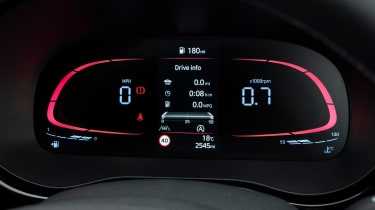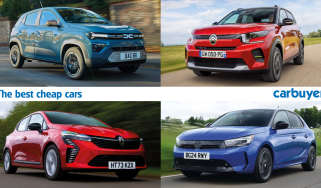Hyundai i10 review - MPG, running costs & CO2
Low running costs despite its conventional petrol engines
The Hyundai i10 is available with a 1.0-litre and 1.2-litre petrol engine, both of which are very cheap to run for traditional combustion engines. However, they face stiff competition from the growing number of city cars with hybrid technology, and key rivals like the Fiat 500 are moving away from petrol entirely in favour of electric power.
Hyundai i10 MPG & CO2
Some potential buyers will be disappointed the engines from the old Hyundai i10 have been carried over almost unchanged. There's nothing fundamentally wrong with either, which is just as well because Hyundai may not deem it worthwhile to develop electrified options for the cheap i10.
In its most efficient 1.0-litre petrol guise with a manual gearbox, the i10 can manage up to 53.3mpg and CO2 emissions of 120g/km. Opting for the automatic only drops fuel efficiency by a few MPG, while CO2 slightly increases. Whether or not you go for the more powerful 1.2-litre will come down to your initial budget rather than daily running costs, with 51.4mpg (49.6mpg for the automatic) and CO2 emissions of up to 130g/km unlikely to be noticeably more costly than the smaller engine.
The i10 is more economical than the petrol Volkswagen up!, which manages around 50mpg, while the Toyota Aygo X can return up to 58.9mpg and emits as little as 109g/km. Fiat has introduced mild-hybrid technology into its 500 and Panda city cars, boosting fuel economy by up to 30%, but the 500 Mild Hybrid still only manages around 53mpg. The SEAT Mii electric and Skoda Citigo e iV became fully electric, with a range of 170 miles and a full charge costing a few pounds. They’re no longer available new, and the base electric Fiat 500 starts from around £28,000, with a range of up to 118 miles between charges.
More reviews
While it's hardly a hot hatch like the Hyundai i20 N, the turbocharged engine in the 1.0-litre i10 N Line has considerably more power, without a big running cost penalty. Thanks to the inherent efficiency of turbo engines, it still manages up to 52.3mpg and emits 123g/km, making it the ideal car for petrolheads on a tight budget. After around 450 miles of driving, we averaged around 42mpg, which wasn’t bad considering we were enjoying the N Line’s performance when there was a clear road ahead.
Insurance groups
No version of the i10 is expensive to insure, as all occupy low insurance groups. The 66bhp engine with the automatic gearbox in Advance and Premium trim gets the lowest rating, making it one of a handful of insurance group one cars on sale. Other versions sit in groups two to six, while the turbocharged i10 N Line is only slightly higher sitting in group 10 – an ideal pick for young and learner drivers after a fun car to drive.
Warranty
Hyundai offers a highly competitive warranty lasting five years with no mileage limit that's more generous than the three years offered by Volkswagen Group brands. The Kia Picanto and Toyota Aygo X are the only rivals that beat it, with seven and ten years of cover respectively, each covering up to 100,000 miles.
Servicing
Hyundai offers reasonably priced servicing and i10 buyers will be offered maintenance deals to cover the car for a set time. This can be paid upfront or monthly to spread the cost.














